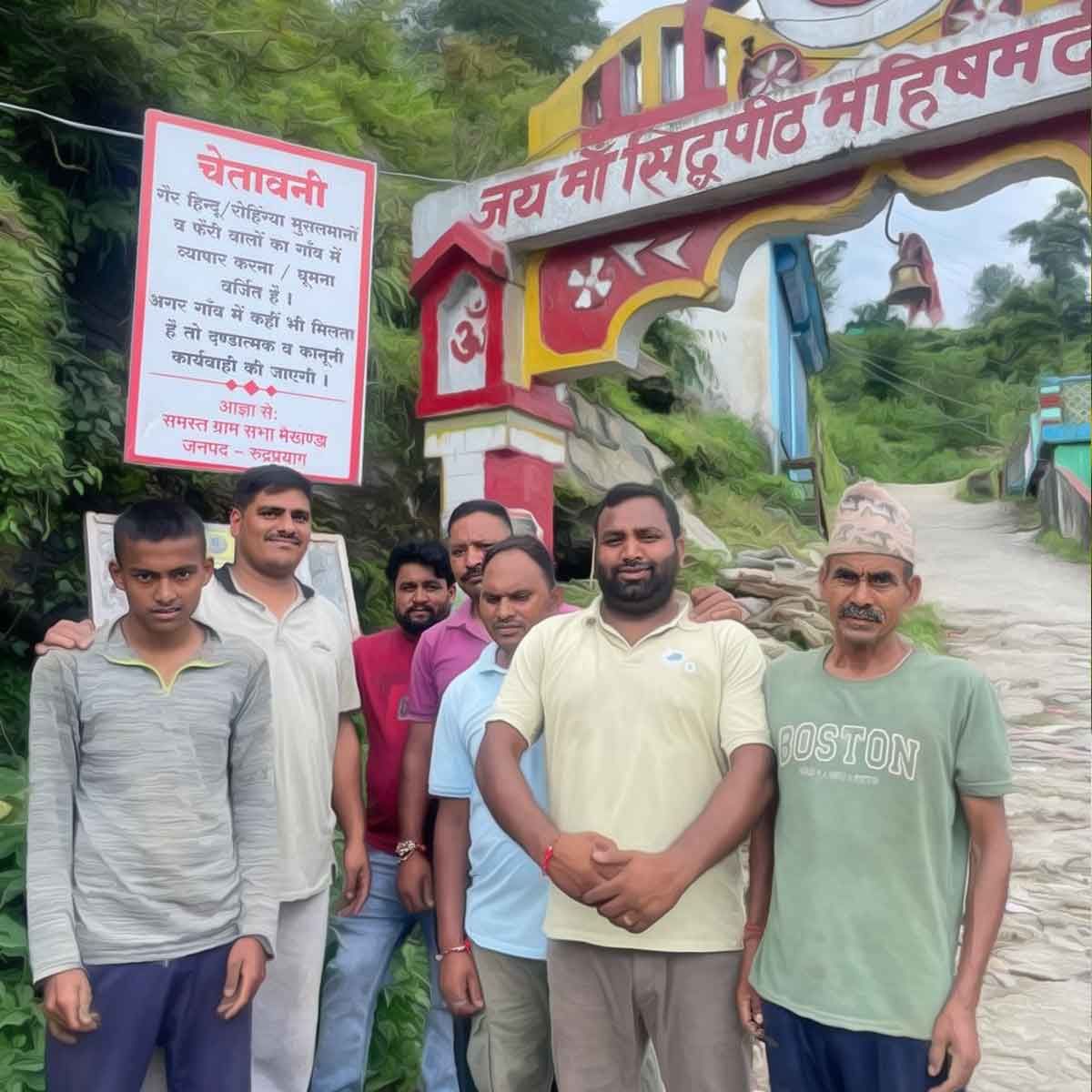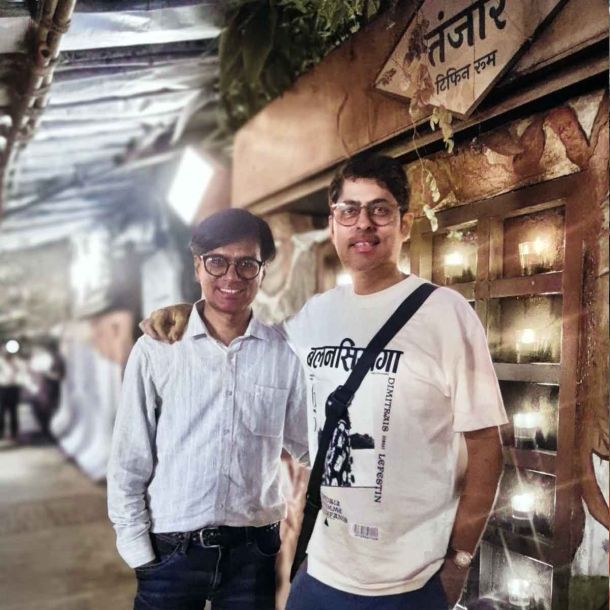More Coverage
Twitter Coverage
Satyaagrah
Written on
Satyaagrah
Written on
Satyaagrah
Written on
Satyaagrah
Written on
Satyaagrah
Written on
JOIN SATYAAGRAH SOCIAL MEDIA
"जागते रहो": In Uttarakhand, Hindu villagers install boards to prohibit the entry of non-Hindus and Rohingya Muslims citing safety; faced with a smear campaign by leftists and Islamists, police adjust signs to restrict 'outsiders' after discussions

In a striking development from Uttarakhand, commonly referred to as Dev Bhoomi or the 'Land of Gods', tensions have surged following the placement of signboards that explicitly restricted the entry of non-Hindus, Rohingya Muslims, and hawkers in various villages. This initiative has been predominantly observed in the Rudraprayag district. These signs were reportedly erected in response to escalating crime rates and the involvement of external elements in serious criminal activities.
|
The catalyst for this stringent measure was a disturbing incident in the Chamoli district, where a Muslim salon owner was accused of an indecent act against a minor Hindu girl in the Nandprayag area. This event not only shocked the local community but also spurred considerable unrest and demands for stringent actions against certain community members. The outrage was palpable as locals organized massive protests to voice their grievances and demand justice.
In the wake of these protests, the police intervened, initiating dialogues with the concerned villagers. During these discussions, modifications were made to the content displayed on these banners. Originally singling out 'non-Hindus' and 'Rohingya Muslims,' the signs were altered to more generally prohibit 'outsiders.' Furthermore, several of the initial posters bearing the original wording were removed by the police to ease tensions.
Amid these changes, social media has played a significant role in spreading information about the signs, with images of the revised boards circulating widely. These boards are a visible symbol of the community's desire to regulate and monitor the influx of outsiders, which they associate with increased security risks.
Pramod Singh, the pradhan of Nyalsu village, confirmed that such boards have been installed in nearly every village in the area. The list of villages includes Shersi, Gaurikund, Triyuginarayan, Sonprayag, Barasu, Jamu, Ariya, Ravigram, and Maikhanda, highlighting a widespread initiative to safeguard the local communities from potential threats posed by unfamiliar individuals.
Continuing from the heightened security measures across Uttarakhand villages, the installation of signboards with explicit warnings against non-Hindus and Rohingya Muslims has extended to Maikhanda village. Chandni Devi, the Pradhan of Maikhanda, confirmed the presence of a board that mirrors those seen in other localities, underscoring a region-wide initiative to control the entry of certain groups into these rural areas.
|
In Sonprayag, another village in the Rudraprayag district, the local community has taken a slightly more stringent approach. The board there warns, "non-Hindus and Rohingyas will face action if they enter the village." This message is accompanied by a hefty penalty for violators, setting a fine of Rs 5000, which underscores the seriousness with which the villagers view this mandate. Such measures reflect a collective effort to safeguard the community from perceived external threats and maintain social order within their confines.
Similarly, Nyalsu village has adopted a comprehensive stance against the presence of non-Hindus, Rohingya Muslims, and hawkers within its boundaries. The board outside the village states, "It is prohibited for non-Hindus/Rohingya Muslims and hawkers to do business/roam around in the village. If found anywhere in the village, punitive action will be taken." This directive, issued by the Gram Sabha, is part of a broader strategy to monitor and control the movement of outsiders, thereby ensuring the security and well-being of the village residents.
Pramod Singh, the Nyalsu Pradhan, elaborated on the rationale behind these measures. He explained that the restrictions on hawkers are particularly stringent. Given that many male residents are absent during the yatra season, spending time in areas like Gaurikund and Sonprayag, the village's women are often home alone. This situation heightens the villagers' concerns about unverified hawkers who might enter the village without proper identification and police verification. Singh emphasized that while hawkers with verified credentials who have been visiting regularly are not barred, the primary concern lies with those who could potentially commit crimes and elude capture due to the lack of traceable identification.
As the situation in Rudraprayag district continues to evolve, details about the origins and enforcement of the signboards have come to light. Pramod Singh, in a statement to Hindustan Times, clarified that the signboards placed around Nyalsu village were not an official action of the gram panchayat but rather an initiative taken by the villagers themselves. This distinction highlights the grassroots level of community involvement and the residents' commitment to self-regulate in response to their safety concerns.
The local police have also acknowledged the presence of these contentious signboards throughout the district. Dinesh Bharne, a spokesperson for the Uttarakhand Police, confirmed their existence and elaborated on the steps being taken by law enforcement to address the community tensions that have arisen as a result. The police are actively engaging with the local population, aiming to defuse the situation through dialogue and understanding, reflecting an approach that seeks to balance community concerns with legal and social norms.
Adding to the police's response, Bharne noted that in alignment with directives from Chief Minister Pushkar Singh Dhami, a thorough verification process for outsiders is being conducted. This process is part of a broader security measure intended to ensure that all individuals entering the villages are properly vetted. Furthermore, the spokesperson assured that any additional complaints received in this context would be promptly investigated, indicating a proactive and responsive approach by the Uttarakhand Police to maintain peace and order in the region.
|
While Villagers Defended the Banners Citing Security Concerns, Islamists and Leftists Peddle a Victimhood Narrative
In Rudraprayag district, where traditional values intertwine closely with daily living, the villagers have implemented precautionary measures, particularly through the installation of signboards aimed at controlling access to their communities. These measures have been instated strictly due to escalating security concerns, underscored by a unanimous decision among the residents.
A resident of Sirsi village, Ashok Semwal, provides a clear justification for these precautions. He points out that the demographic structure of the village often involves many men traveling away for work, leaving women and children at home. This scenario increases their susceptibility to potential threats. Semwal elaborates that the implementation of these posters is a proactive measure to ensure that anyone entering the village has proper verification or identification, a policy spurred by previous incidents, including temple thefts which have unsettled the community. The primary intent behind these measures is to safeguard the residents and their properties from similar violations.
Despite the clarity and uniformity in the villagers’ rationale, their actions have been met with substantial criticism. Various groups from Islamist and leftist circles, along with certain social media platforms, have portrayed these security measures as exclusionary or discriminatory, suggesting a narrative of victimization. However, these critiques often overlook the genuine concerns of the villagers, who have direct experiences and legitimate reasons for tightening security.
|
The criticism also extends to debates around access to temples for non-Hindus, a topic intertwined with the broader security concerns. While some argue for inclusive access, the villagers’ stance is that the sanctity and security of their religious spaces must be maintained, especially given past security breaches. The locals believe that safeguarding these spaces is not about exclusion but about preserving the cultural and religious integrity of the area, ensuring that those who enter are respectful and properly vetted.
|
Amidst this controversy, figures like Zakir Ali Tyagi have criticized the local decisions, urging Prime Minister Narendra Modi to intervene. This criticism has been amplified by Muslim organizations and leaders, with Dr. Nayyar Kazmi of AIMIM meeting Uttarakhand’s Director General of Police to demand legal action against those who installed the boards. Kazmi has also signaled potential protests led by AIMIM if the demands are not met within a week.
Despite these objections, the rationale provided by local residents for the installation of these signboards is deeply rooted in a desire to enhance safety within their communities. The signs, which initially restricted entry based on religious affiliation, were erected in response to specific incidents that raised concerns about the safety of village residents, particularly in contexts where men are frequently away from home, leaving their families vulnerable.
|
Senior Congress leader Ganesh Godiyal has also weighed in, suggesting that while criminals should be prosecuted, it is unfair to generalize an entire community as problematic. However, from the perspective of the villagers, the measures are seen not as acts of discrimination, but as necessary steps to protect their community’s welfare. The banners are a direct response to past security breaches, such as temple thefts, which have not only caused physical losses but have also deeply affected the spiritual sanctity of these places.
The villagers’ stance is that ensuring safety and preserving the sanctity of their religious sites should be paramount. These measures are not intended to promote exclusion but are seen as essential to maintaining the cultural integrity and security of their communities. The localized decision-making reflects a community-driven approach to handling issues that they perceive as threats to their way of life and safety.
Thus, while the installation of such banners has been met with significant backlash and labeled by some as a form of victimization, for many villagers, these actions are about preserving a way of life and ensuring that their religious and cultural environments are shielded from potential harms that have been previously experienced.
 Support Us
Support Us
Satyagraha was born from the heart of our land, with an undying aim to unveil the true essence of Bharat. It seeks to illuminate the hidden tales of our valiant freedom fighters and the rich chronicles that haven't yet sung their complete melody in the mainstream.
While platforms like NDTV and 'The Wire' effortlessly garner funds under the banner of safeguarding democracy, we at Satyagraha walk a different path. Our strength and resonance come from you. In this journey to weave a stronger Bharat, every little contribution amplifies our voice. Let's come together, contribute as you can, and champion the true spirit of our nation.
 |  |  |
| ICICI Bank of Satyaagrah | Razorpay Bank of Satyaagrah | PayPal Bank of Satyaagrah - For International Payments |
If all above doesn't work, then try the LINK below:
Please share the article on other platforms
DISCLAIMER: The author is solely responsible for the views expressed in this article. The author carries the responsibility for citing and/or licensing of images utilized within the text. The website also frequently uses non-commercial images for representational purposes only in line with the article. We are not responsible for the authenticity of such images. If some images have a copyright issue, we request the person/entity to contact us at This email address is being protected from spambots. You need JavaScript enabled to view it. and we will take the necessary actions to resolve the issue.
Related Articles
- Miles2Smiles Foundation seeking donations to help ‘victims’ of the anti-encroachment drive in Jahangirpuri: Previously raised funds for illegal Rohingya Muslim immigrants settling in the country
- Gurugram: Police detain Hindu activists protesting public Namaz, Muslim groups call ‘more people’ from Rohingya infested Nuh for ‘support’
- The true face of Saba Naqvi: How the ‘secular journalist’ supported Muslims acts of violence and fanaticism on Ram Sevaks in Sabarmati Express burning leading to gruesome killing of some 59 innocent people, including 25 women and 15 children
- “Bharat se Ghenhu nehi mangayega UAE”: Amid global crisis due to Russia-Ukraine war, UAE suspends re-export of wheat imported from India for food security, Low IQ Islamists rejoice after NDTV said UAE will not import wheat from India
- While Shaheen Bagh showcases its latest artwork for anti-CAA 'protest', it also reveals its true nature of Islamist supremacy and Hinduphobia: Adds image of Hindu Swastika being ‘smashed’ and disintegrating
- Elderly woman gang-raped in front of grandson, minor Dalit girl gang-raped and left to die in jungle: WB horror stories emerge
- Bengal: Calcutta HC Asks NHRC To Examine Pleas Of People Displaced By Post-Poll Violence; Warns State Government Against Obstruction
- Master of fabrication and deceit: 4 occasions where eminent “historian” D N Jha misled to suit the narrative
- 26 Dec 2021 to 1 Jan 2022 - Routine summary of persecution, hate-crimes and discrimination against Hindus: Hindus under attack
- ‘State in denial, admin lied about no complaints being filed, prima facie evidence of violence’: Everything Calcutta HC said on Bengal post-poll violence
- ‘Tricked into religious conversion for marriage and then father in law demanded sex’, J&K woman reveals her ordeal
- We present a list of trickery, hypocrisy, and biases of the Islamist propagandist Rana Ayyub as she manages to embarrass herself again by infuriating netizens of Saudi Arabia
- The ‘Sanghi propaganda’ trope on abduction and conversion of Sikh girls to Islam. Here is how this online tirade is an omen of impending danger
- Hitler’s propaganda minister Joseph Goebbels said 'Repeat a lie often enough and it becomes the truth' - Whitewashing a genocide – how the exodus of Kashmiri Pandits is being blamed on Hindus instead of on Islamists
- Bengal: The Chilling Accounts Of Families Of Two BJP Workers Who Can Return Home Only If The Women Are ‘Given Up’ To Trinamool Gangsters




























